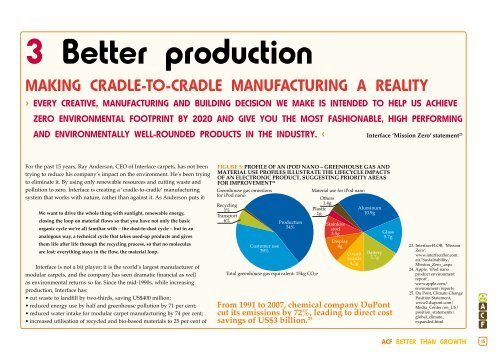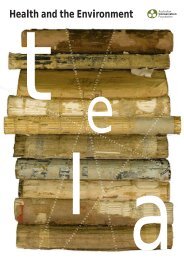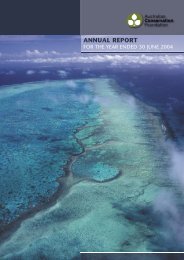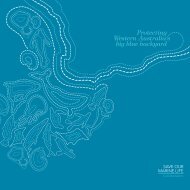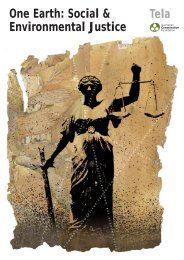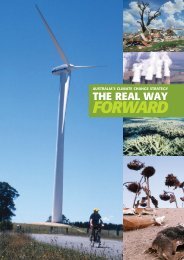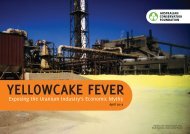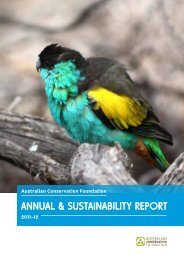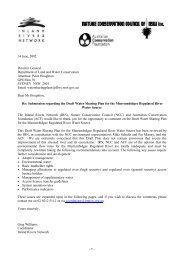Better than growth - Australian Conservation Foundation
Better than growth - Australian Conservation Foundation
Better than growth - Australian Conservation Foundation
You also want an ePaper? Increase the reach of your titles
YUMPU automatically turns print PDFs into web optimized ePapers that Google loves.
3 <strong>Better</strong> production<br />
making cradle-to-cradle manufacturing a reality<br />
› Every creative, manufacturing and building decision we make is intended to help us achieve<br />
zero environmental footprint by 2020 and give you the most fashionable, high performing<br />
and environmentally well-rounded products in the industry. ‹ interface ‘Mission Zero’ statement 23<br />
For the past 15 years, Ray Anderson, CEO of Interface carpets, has not been<br />
trying to reduce his company’s impact on the environment. He’s been trying<br />
to eliminate it. By using only renewable resources and cutting waste and<br />
pollution to zero, Interface is creating a ‘cradle-to-cradle’ manufacturing<br />
system that works with nature, rather <strong>than</strong> against it. As Anderson puts it:<br />
We want to drive the whole thing with sunlight, renewable energy,<br />
closing the loop on material flows so that you have not only the basic<br />
organic cycle we’re all familiar with – the dust-to-dust cycle – but in an<br />
analogous way, a technical cycle that takes used-up products and gives<br />
them life after life through the recycling process, so that no molecules<br />
are lost; everything stays in the flow, the material loop.<br />
Interface is not a bit player; it is the world’s largest manufacturer of<br />
modular carpets, and the company has seen dramatic financial as well<br />
as environmental returns so far. Since the mid-1990s, while increasing<br />
production, Interface has:<br />
• cut waste to landfill by two-thirds, saving US$400 million;<br />
• reduced energy use by half and greenhouse pollution by 71 per cent;<br />
• reduced water intake for modular carpet manufacturing by 74 per cent;<br />
• increased utilisation of recycled and bio-based materials to 25 per cent of<br />
FIGURE 5: PROFILE OF AN iPOD NANO – GREENHOUSE GAS AND<br />
MATERIAL USE PROFILES ILLUSTRATE THE LIFECYCLE IMPACTS<br />
OF AN ELECTRONIC PRODUCT, SUGGESTING PRIORITY AREAS<br />
FOR IMPROVEMENT 24<br />
Greenhouse gas emissions<br />
for iPod nano<br />
Recycling<br />
1%<br />
Transport<br />
6%<br />
Customer use<br />
39%<br />
Production<br />
54%<br />
Total greenhouse gas equivalent: 15kg CO 2e<br />
Material use for iPod nano<br />
Others<br />
1.4g<br />
Plastic<br />
1g<br />
Stainless<br />
steel<br />
3.5g<br />
Display<br />
4g<br />
Circuit<br />
boards<br />
4.2g<br />
Aluminum<br />
10.9g<br />
Battery<br />
5.7g<br />
Glass<br />
5.7g<br />
From 1991 to 2007, chemical company DuPont<br />
cut its emissions by 72%, leading to direct cost<br />
savings of US$3 billion. 25<br />
23. InterfaceFLOR, ‘Mission<br />
Zero‘,<br />
www.interfaceflor.com.<br />
au/Sustainability/<br />
Mission_Zero_.aspx<br />
24. Apple, ‘iPod nano<br />
product environment<br />
report‘,<br />
www.apple.com/<br />
environment/reports<br />
25. Du Pont, Climate Change<br />
Position Statement,<br />
www2.dupont.com/<br />
Media_Center/en_US/<br />
position_statements/<br />
global_climate_<br />
expanded.html<br />
ACF BETTER THAN GROWTH 15


